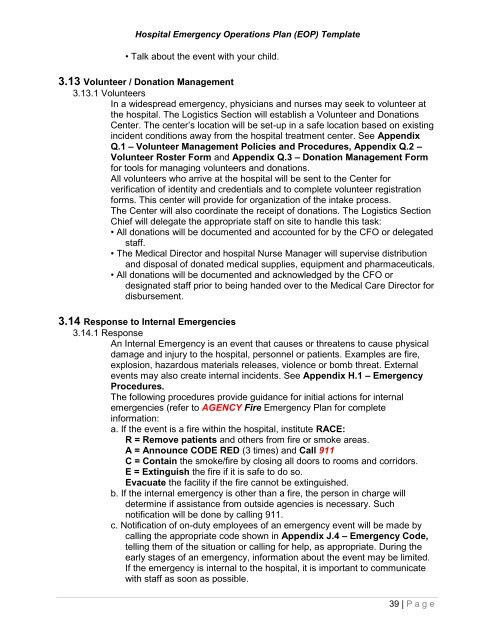Hospital Emergency Operations Plan (EOP) TEMPLATE
Hospital Emergency Operations Plan (EOP) TEMPLATE
Hospital Emergency Operations Plan (EOP) TEMPLATE
Create successful ePaper yourself
Turn your PDF publications into a flip-book with our unique Google optimized e-Paper software.
<strong>Hospital</strong> <strong>Emergency</strong> <strong>Operations</strong> <strong>Plan</strong> (<strong>EOP</strong>) Template<br />
• Talk about the event with your child.<br />
3.13 Volunteer / Donation Management<br />
3.13.1 Volunteers<br />
In a widespread emergency, physicians and nurses may seek to volunteer at<br />
the hospital. The Logistics Section will establish a Volunteer and Donations<br />
Center. The center’s location will be set-up in a safe location based on existing<br />
incident conditions away from the hospital treatment center. See Appendix<br />
Q.1 – Volunteer Management Policies and Procedures, Appendix Q.2 –<br />
Volunteer Roster Form and Appendix Q.3 – Donation Management Form<br />
for tools for managing volunteers and donations.<br />
All volunteers who arrive at the hospital will be sent to the Center for<br />
verification of identity and credentials and to complete volunteer registration<br />
forms. This center will provide for organization of the intake process.<br />
The Center will also coordinate the receipt of donations. The Logistics Section<br />
Chief will delegate the appropriate staff on site to handle this task:<br />
• All donations will be documented and accounted for by the CFO or delegated<br />
staff.<br />
• The Medical Director and hospital Nurse Manager will supervise distribution<br />
and disposal of donated medical supplies, equipment and pharmaceuticals.<br />
• All donations will be documented and acknowledged by the CFO or<br />
designated staff prior to being handed over to the Medical Care Director for<br />
disbursement.<br />
3.14 Response to Internal Emergencies<br />
3.14.1 Response<br />
An Internal <strong>Emergency</strong> is an event that causes or threatens to cause physical<br />
damage and injury to the hospital, personnel or patients. Examples are fire,<br />
explosion, hazardous materials releases, violence or bomb threat. External<br />
events may also create internal incidents. See Appendix H.1 – <strong>Emergency</strong><br />
Procedures.<br />
The following procedures provide guidance for initial actions for internal<br />
emergencies (refer to AGENCY Fire <strong>Emergency</strong> <strong>Plan</strong> for complete<br />
information:<br />
a. If the event is a fire within the hospital, institute RACE:<br />
R = Remove patients and others from fire or smoke areas.<br />
A = Announce CODE RED (3 times) and Call 911<br />
C = Contain the smoke/fire by closing all doors to rooms and corridors.<br />
E = Extinguish the fire if it is safe to do so.<br />
Evacuate the facility if the fire cannot be extinguished.<br />
b. If the internal emergency is other than a fire, the person in charge will<br />
determine if assistance from outside agencies is necessary. Such<br />
notification will be done by calling 911.<br />
c. Notification of on-duty employees of an emergency event will be made by<br />
calling the appropriate code shown in Appendix J.4 – <strong>Emergency</strong> Code,<br />
telling them of the situation or calling for help, as appropriate. During the<br />
early stages of an emergency, information about the event may be limited.<br />
If the emergency is internal to the hospital, it is important to communicate<br />
with staff as soon as possible.<br />
39 | P a g e













